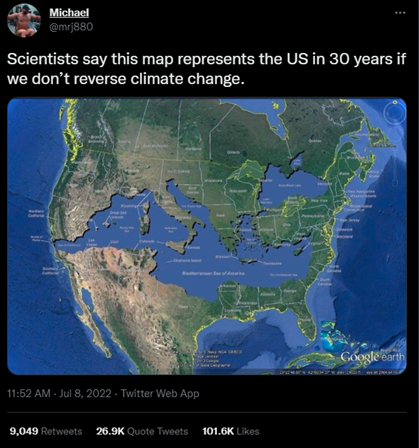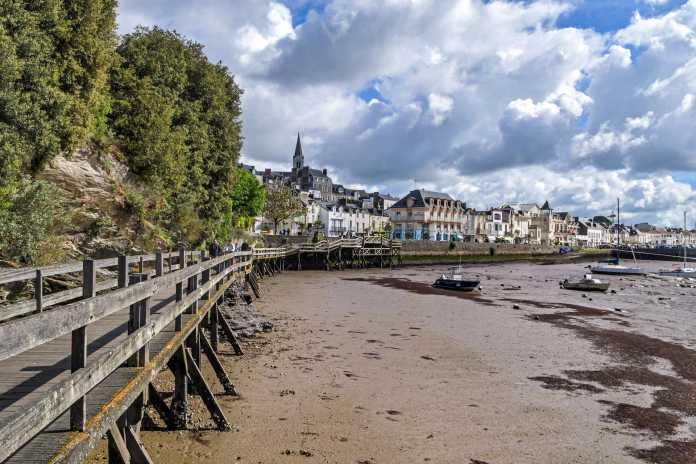The Independent recently ran a story discussing an image that went viral over the weekend purporting to show of what the United States will look like in only a few decades if climate change is not “reversed.” To the Independent’s credit, they debunked the false image, explaining the issues with the map. Not content to correct the false future portrayed by the image, however, the news site pivoted to propagating its own false claims concerning rising sea levels.
The article, “Map which claimed to show US climate impacts in 2050 is debunked as photo of the Mediterranean Sea,” explains the origin of a recent viral Twitter post claiming to show a map of the U.S. in 30 years if climate change continues. In reality, the image is just a map of the Mediterranean Sea laid on top of a U.S. map from Google Images.
The Independent failed to recognize, however, that the linked Tweet is a meme—an absurdist joke posted that almost everyone on Twitter except professional journalists understood. Hilariously, the Twitter account that posted the meme has subsequently reposted his “debunking” by professional news organizations, even setting his profile banner to one of the article headlines missing the joke. The fact that Italy is laid across the central United States is, apparently, something journalists think plenty of people will fail to notice.

The fact that the post was so widely distributed with some Twitter users expressing genuine alarm in the comments does lend The Independent a modicum of credit for discussing it.
One of The Independent’s biggest gripes with the obvious meme is that it shows water in the center of the country, asserting instead that “[a]s sea level rises, the coastlines are going to be eaten away, carving out low-elevation areas in states like Florida, Delaware, and the Carolinas.”
The article goes on to claim that human emissions of CO2 are causing sea level rise, a claim refuted by current data and research on prehistoric sea level trends.
The Independent paints a dire future:
Even if the world drastically reduces greenhouse gas emissions, sea levels are projected to rise by at least half a metre (1.6 feet) by the end of the century, according to the most recent report from the Intergovernmental Panel on Climate Change (IPCC).
With higher emissions, sea levels could rise by six metres (20 ft) or more by the year 2300, IPCC says. In such a scenario, places like New York City, Bangladesh, and Amsterdam would be almost unrecognizable.
As Climate Realism has pointed out many times, here, here, and here, for example, present sea level rise is not outside of the average historical rate experienced since the end of the last ice age. Claims that sea levels are rising at unusually rapid rates, are based on flawed climate models using impossible climate model simulation pathways, like RCP8.5, or a faulty analysis of sea levels measured by satellites.
A variety of factors contribute to sea level rise—including the expected warming as the Earth exits the last glacial period—and data show that the current rate is not unusual. Claims that it is accelerating are hotly debated. Data shown below from tide gauges in New York, for instance, show a relatively stable rate of rise since the mid-1800s. The fact is sea level always rises during the interglacial periods until the next ice age arrives.

Local increases or decreases in rates of sea level change can be caused by tectonics, local groundwater displacement causing land subsidence, over construction of dwellings on coastlines causing compaction, wetland destruction, and other influences. All contribute to the varied rates of change seen on coastlines around the world.
Predictions of rapid sea level rise swallowing entire island nations and coasts, displacing residents, have been made for decades, not a single one has come to pass. For example, the claim that the island nation of Tuvalu is slipping beneath the waves due to sea level rise has been proven false time and again. In the Climate Realism post, “Yahoo News Repeats the False Claim Tuvalu Is Sinking Beneath Rising Seas, Data Show It Is Growing,” H. Sterling Burnett points out that most of the islands in the chain are remaining stable or even are experiencing landmass growth.
The Independent struggled to notice that the post they were “debunking” was a joke, instead soberly and gravely informing readers that the prediction was unrealistic, and then immediately pivoted to make their own unrealistic claims about sea level rise. Perhaps, in addition to getting their funny bones checked, writers and editors at mainstream corporate news sources might think about checking actual data before parroting alarmist talking points.



















Sea level change is complicated, not least because subsea subduction draws billions of litres of seawater below the crust, but also because the thin crust underlying ocean basins is elastic, depressing as rising water levels add more pressure to the sea floor. Ocean basins are more like stretchy water-filled balloons than rigid bathtubs…